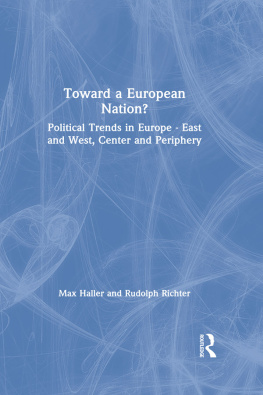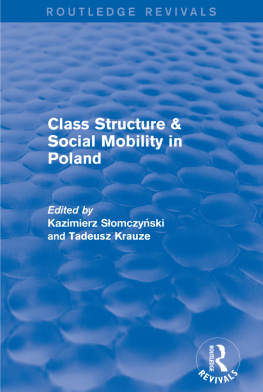CLASS STRUCTURE IN EUROPE
CLASS STRUCTURE IN EUROPE
New Findings from East-West Comparisons of Social Structure and Mobility
Edited by
Max Haller
First published 1990 by M.E. Sharpe
Published 2015 by Routledge
2 Park Square, Milton Park, Abingdon, Oxon OX14 4RN
711 Third Avenue, New York, NY 10017, USA
Routledge is an imprint of the Taylor & Francis Group, an informa business
Copyright 1990 Taylor & Francis. All rights reserved.
No part of this book may be reprinted or reproduced or utilised in any form or by any electronic, mechanical, or other means, now known or hereafter invented, including photocopying and recording, or in any information storage or retrieval system, without permission in writing from the publishers.
Notices
No responsibility is assumed by the publisher for any injury and/or damage to persons or property as a matter of products liability, negligence or otherwise, or from any use of operation of any methods, products, instructions or ideas contained in the material herein.
Practitioners and researchers must always rely on their own experience and knowledge in evaluating and using any information, methods, compounds, or experiments described herein. In using such information or methods they should be mindful of their own safety and the safety of others, including parties for whom they have a professional responsibility.
Product or corporate names may be trademarks or registered trademarks, and are used only for identification and explanation without intent to infringe.
The essays in this collection appeared in earlier forms in the International Journal of Sociology (vol. 19, nos. 2, 3, and 4).
Library of Congress Cataloging-in-Publication Data
Class structure in Europe : new findings from East-West comparisons of social structure and mobility / Max Haller, editor.
p.cm.
Includes bibliographical references.
ISBN 0-87332-722-5
1. Social classesEurope. 2. Social classesEurope, Eastern. 3. Social mobilityEurope. 4. Social mobilityEurope, Eastern. I. Haller, Max, Dr.
HN380.Z9S6371990
ISBN 13: 9780873327220 (hbk)
Contents
Part I
Class and Social Structures in Europe and Beyond
Dieter Holtmann and Hermann Strasser
The Stability of Occupational Structures, Social Mobility, and Interest Formation
The USSR as an Estatist Society in Comparison with Class Societies
Wolfgang Teckenberg
Part II
Educational Systems and Patterns of Mobility
Walter Mller, Paul Lttinger, Wolfgang Knig, and Wolfgang Karle
On the Changing Role of Education in Social Reproduction in Different Sociopolitical Systems
A Comparative Analysis between the Netherlands and Poland
Bogdan W. Mach and Jules L. Peschar
Family Background and Educational Attainment in Czechoslovakia and the Netherlands
The Analysis of Cultural and Economic Sources of Inequality in Comparative Perspective
Petr Matj and Jules L. Peschar
Part III
Mobility Regimes in East Central Europe: Did Socialist Revolution Make a Difference?
Social Mobility in Austria, Czechoslovakia, and Hungary
An Investigation of the Effects of Industrialization, Socialist Revolution, and National Uniqueness
Max Haller, Tams Kolosi, and Pter Rbert
Rudolf Andorka
Transition to Socialism and Intergenerational Class Mobility
The Model of Core Social Fluidity Applied to Czechoslovakia
Marek Boguszak
Tables
Holtmann and Strasser
Teckenberg
Mller, Lttinger, Knig, and Karle
Mach and Peschar
Maty and Peschar
Haller, Kolosi, and Rbert
Andorka
Boguszak
Figures
Holtmann and Strasser
Mach and Peschar
Maty and Peschar
Boguszak
European Class Structure: Does It Exist?
The question of the existence of a particular European class structure does not play an important role in theorizing about, and research of, the social structure of present-day societies. Some authors argue that the advent of mass affluence and public welfare in advanced nations has deprived class structures of their former importance, if it has not abolished them altogether (Offe 1969; Gorz 1980). The implications of this thesis seem to converge with those theories that postulate an inherent logic of industrial development. This logic, in the long run, would lead toward a decrease of extreme forms of inequality, an increase of social mobility, and a convergence of the social structures of advanced nations into one generic type of postindustrial society (Lipset and Bendix 1959; Treiman 1970; Bell 1973). Contrary to these authors, neomarxist sociologists argue that the class character of the capitalist system in its fundamental lines is still alive throughout all Western societies (Poulantzas 1975; Wright 1985). What all these authors have in common is that the possibility of significant international or intercultural differences in the class structures of advanced societies does not occupy a substantial place in their thinking on the subject.
There is another tradition that lays more importance on such differences. Starting with the famous work of Alexis de Tocqueville (1835), it has concentrated primarily on the comparison of the first new nation (Lipset 1979), the United States of America, with Europe. The widely held assumption in these analyses has been, as stated by Lipset and Bendix (1959, pp. 11ff.), that America has an open society with considerable social mobility, but the countries of Western Europe have societies that are closed. This belief can be traced back to the age of the French Revolution when, for the first time, America appeared as the land free from traditional institutions and historical legacies.
There was little systematic comparative research investigating this assumption until the middle of the twentieth century. In the 1960s and 1970s a series of articles were published, sketching out the main characteristics of European class structure and its changes during the postwar decades.
In one of these reviews, Dahrendorf (1972) concluded that the main trend in the postwar change of class structures in Europe has been that of the emergence of the new service class and the increasing dominance of the values of its members. For Dahrendorf, it was not entirely clear whether this was a truly European phenomenon, or a more general tendency, facing all advanced industrial societies sooner or later. In a review of political trends, Lipset (1964, p. 295) found evidence for the moderation of ideological differences in Europe as a consequence of the increasing affluence of its nations, the attainment of economic and political citizenship by the workers, and the gradual absorption and assimilation of the remnants of European society still living in feudal or otherwise underdeveloped economic and social conditions.
Particularly relevant for the analyses presented in this collection of papers are two conclusions which Archer and Giner draw from their comparative survey of literature and data on Social Stratification in Europe. First, they state, serious doubts must be raised about any theory maintaining a unilinear pattern of social stratification. Second, excessive optimism derived from observed increases in open competition, minimization of aristocratic privileges, and the extension of democratic politics, should be qualified by the recognition that each of these trends can coexist with a multiplicity of stratification systems, some of whose elements may limit, neutralize, or counteract these trends (Archer and Giner 1971, p. 48).







